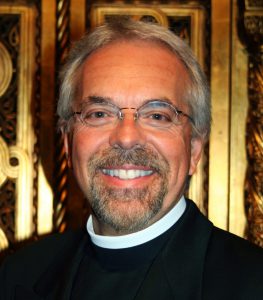
Fr Frank Marangos
Source: OINOS Educational Consulting
By Frank Marangos, D.Min., Ed.D., FCEP
John 19:20
Schools of theological education rest at the crossroads of society. Like the raised “bema” of the ancient Greek philosophers and the “platform step” of the Jewish synagogue (Neh. 8:4), the educational pulpit of the nation’s institutions of theological higher learning were originally established to engage the intersection of church, culture, and commerce. To continue to effectively do so, however, contemporary theological schools and seminaries must overcome a myriad of challenges in order to advance their mission of fastidiously forming skilled Christian communicators.For centuries, central destinations have claimed the cosmopolitan sobriquet of “crossroad of the world.” Whether self-adorned or awarded by historians, harbors, palaces, and religious landmarks all alleged the coveted moniker. A dispassionate assessment, however, leads one to identify Golgotha, the hill-top location of Jesus Christ’s crucifixion, as the most influential of historical cloverleafs.
During His lifetime, Jesus used a variety of cultural pulpits from which to communicate His message. He employed Peter’s boat, Jacob’s well, Jerusalem streets, Bethesda porticos, and Galilean hills. The most majestic pulpit of all, however, was the crossbeams upon which the blood-stained missive of His Passion was inscribed in Hebrew, Roman, and Greek – the languages of the three major cultural groups of that era (John 19:20).
The Cross is then the pulpit, the “bema,” of the New Testament. It is the towering dais from which the primary dispatch of God’s love and forgiveness is eternally transmitted on outstretched arms. As one of its primary interlocuteurs, theological schools and seminaries must, therefore, not allow current challenges to sideline their institutions from effectively advancing their primary mission, namely, the communication of God’s truths from the crossroads of society.
According to the 3rd General Standard of Accreditation of the Association of Theological Schools (ATS), “communication should extend beyond a theological school’s immediate environment to relate it to the wider community of the church, the academy, and the society.” Apart from its classroom and chapel, a theological school’s institutional culture has a major impact on the educational experience of their students. Consequently, apart from being a distinctive characteristic of its graduates, communication should also be considered a vital expression of a theological school’s institutional culture.
If contemporary religious schools of higher learning are interested in adhering to ATS’s 3rd general Standard, they must, therefore, evaluate the degree to which their (1) institutional communications are theologically-based, and (2) educational delivery systems form graduates who are skilled and competent communicators.
Theology of Communications
The American nation needs religious leaders with the knowledge, skills, and sensitivities to engage and effectively challenge its secular post-Christian culture. If theological schools and seminaries desire to effectively develop such competent religious leaders, their academy’s communications should faithfully emulate the elements of a sound pastoral theology. Fortunately, the 52-year repository of Papal Messages, prepared for the Catholic Church’s annual celebration of World Communications Day, as well as official Patriarchal statements of the Greek Orthodox Church, provide valuable material for the development of such a substantive framework.
World Communications Day was established by Pope Paul VI in 1967 as an annual celebration to reflect and discuss the opportunities and challenges of social communications. The celebration was created in response to the 2nd Vatican Council (1962–65), whose opening statement on The Church in the Modern World, exhorted the Catholic Church in particular to resist the escapist urge and more fully engage contemporary culture.
Since the inception of World Communication Day, Papal successors have employed Christian theological principles to consistently examine the opportunities and threats that communication technologies afford the enriching of human lives “with the values of truth, beauty and goodness.” In his first of twelve World Communications Day messages (1967-1978), Pope Paul referred to communications as a “noble service.” The Pontiff exhorted the Church to, therefore, “make her own contribution to the orderly development of the world of social communications: a contribution of inspiration, encouragement, exhortation, guidance and cooperation.”
During his tenure on the Vatican Throne, John Paul II, subsequently described communications as “a platform of exchange and dialogue (1987),” and “the first Areopagus of the modern age, unifying humanity and turning it into what is known as a global village (2002).” Unlike his predecessors, however, Pope John Benedict XVI focused his missives on communication’s more dangerous features that actually “place humanity at a crossroads (2008).” On the occasion of the 42nd celebration of World Communications Day, Benedict, therefore, suggested the creation of “info-ethics” that, like bioethics, would help “guard against communication’s negative influences.” Only in this fashion, the Pontiff claimed, could the “authentic witnesses to the truth realize the highest vocation of social communication,” namely “seeking and presenting the truth about humanity.”
Like his immediate forerunner, Pope Francis warned that the world of communications “can either help to expand our knowledge or to lose our bearings” (2014). Although Francis referred to communications as a “gift from God,” the current global leader of the Catholic Church also urged that the “power of the digital environment” be employed through expressions of “neighborliness.” In order to do so, the Pontiff’s recommends that leaders employ “the image of the Good Samaritan who tended to the wounds of the injured man by pouring oil and wine as their inspiration. “Let our communication,” Francis exhorts, “be a balm that relieves pain, and a fine wine which gladdens hearts” (2014).Communications, according to Francis, has the power “to build bridges, to enable encounter and inclusion, and thus to enrich society.” “The digital world is a public square,” he suggests, “an agora . . . a meeting-place where we can either encourage or demean one another, engage in a meaningful discussion or unfair attacks.” Finally on the Jubilee celebration of World Communications Day (2016), Francis invites “all people of good will to rediscover the power of mercy” and through “communication and reconciliation, heal ancient wounds, lingering resentments, wounded relationships and restore peace and harmony to families and communities.”
Included in his subsequent pastoral encyclical, The Gift of Priestly Formation (2016), Francis encourages religious leaders to “boldly become citizens of the digital world . . . concerned for and present in the world of communication, in order to dialogue with people today and to help them encounter Christ. The revolution taking place in communications media and in information technologies,” insists the Pontiff, “represents a great and thrilling challenge” that the Church should respond to “with fresh energy and imagination as we seek to share with others the beauty of God.”
The Greek Orthodox Church has often joined Roman Catholic leaders in describing the positive and negative aspects of communication technologies. In a joint 2006 statement with Pope John Paul II, Ecumenical Patriarch Bartholomew, the spiritual leader of 300 million Orthodox Christians worldwide, underscored the Church’s responsibility to appropriate social media because “communication and the Gospel go hand-in-hand.” As “our common vision is that the world we inhabit must be based on Christian values, where government, civil society and religion are partners and not rivals,” the Patriarch and Pope pledged their united efforts to “harness the power of technology, especially the Internet, to spread Christ’s message to all peoples (2006).”
During the 2015 KAICIID Athens Conference onReligion, Cultural Pluralism and Peaceful Coexistence in the Middle East, Bartholomew issued a personal warning. While the “ever-growing dominance of social media is bringing religion back into the daily lives of people,” he insisted, it is simultaneously “challenging religions to revise notions of communication.”
In his 2018 Vatican address, A Common Christian Agenda for the Common Good, Patriarch Bartholomew enlarged his warning by stating that due to the “rapid progression of science and technology . . . technology is no longer man’s servant, but instead is his primary driving force, which requires complete obedience, as well as imposes its own principles on all aspects of life.” While many “worship technology and its highest symbol—the computer—as our god, expecting to receive all our benefits, joy, communication, progress, information, jobs, etc, from it,” Bartholomew warned that “science is a great power, but it is not almighty.”
Most recently, the 2nd International Conference onDigital Media and Orthodox Pastoral Care took place on June 17-20 in Kolympari, Crete under the aegis of His All-Holiness Bartholomew. Apart from the negative aspects threatening the human person, the need for proper preparation, spiritual provision and pastoral responsibility by Church leaders was discussed. Like Pope Benedict’s exhortation for the development of “info-ethics,” the Conference recommended the creation of a “framework of education which would help promote discernment and the healthy and genuinely productive use of digital media.”
A review of the aforementioned Papal/Patriarchal Church documents provides a number of vital theological keystones of a robust theology of Christian communications, whose foundational structure begins with the gift of the Triune God’s Self-Communication. By means of His self-revelation as the “Living Word” (Hebrews 4:12), God disclosed His communicative identity. The foundational assumption of Scripture is not simply that God exists, but that he has communicated through the prophets and apostles, and most decisively through the personal revelation of his incarnate Son. As a result of its encounter with Jesus Christ, humanity recognizes its respective identity as a community of communicating persons, communication with one another and with the Triune God. For most Christians, this encounter is most personally fulfilled in the Eucharistic Presence.
The words “community,” “communion,” and “communicate” are derived from the same New Testament Greek word “koinonia” (Galatian 6:6). Since community without communication is a contradiction, early Christians developed and maintained strong links between their geographically separate communities. In so doing, they displayed the theological understanding that love, peace, and unity require constant and authentic communication.
The practical applications of such a theology of communication are numerous and rich. Theological schools and seminaries will certainly maximize their fundraising efforts if they execute a theologically-based communications strategy that emphasizes mission and includes a coherent inspirational narrative. Unfortunately, many institutions of religious higher education do not take the time to communicate such a consistent message. Sloppy and inauthentic messaging will disenchant major donors and constrain an institution’s overall ability to raise adequate funds. Failure to appropriately align the theological school’s primary narrative with the school’s communications efforts will severely damage an institution’s brand, its fundraising efforts, future enrollment, and its overall survival.
As all fundraising efforts must be done in the context of how a theological school or seminary has decided to engage and present itself to the public, development communications strategies should always be consistent, present clear and honest depictions of strategic aspirations and start with the institution’s overall communications plan. Failure to appropriately align the theological school’s primary narrative with the school’s development efforts will only result in severe damage to the institution’s brand, its fundraising efforts, future enrollment, and its overall survival.
Apart from enhancing institutional fundraising and the formation of effective religious leaders, theologically-based communications, formulated and advanced in an interdisciplinary manner, will assist schools of theological education to more effectively dialogue with the mediated cultures of the world today. Such an institutional culture of communication will enrich the technological use of media by guarding it within moral and ethical parameters. In so doing, the nation’s theological schools and seminars will be given the opportunity to (1) communicate a message of healing, reconciliation, and mutual respect, and (2) simultaneously advance their educational mission in a more consequential fashion.
Theological schools and seminaries would be well served to audit their existing institutional culture of communication in order to determine the degree to which they align with the theological principles outlined in the Orthodox Church’s Patriarch exhortations and the Vatican’s exhaustive repository of World Communications Day Messages.
Student Communications Competencies
If the nations theological schools and seminaries desire to remain at society’s crossroads, they must develop religious leaders who are relevant and proficient communicators. Apart from nurturing a theologically-based institutional culture of communications, they must also strive to effectively form graduates who are sincere, enthusiastic, refrain from over-talking, and have the genuine desire to be relevant and to fairly hear the opinion of others. If unable or unwilling to provide such education and training, religious institutions of higher learning will continue to be nudged to the sideline of irrelevancy. In fact, the graduation of sloppy, inarticulate, and inattentive communicators will only lead to decreasing enrollment, debt, and, finally, more school closures.
Research conducted by the Association of Theological Schools (ATS) has unfortunately concluded that seminary and theological school degree programs do not devote sufficient time in their curriculum to the development of effective communicators. Unfortunately, many member schools require students to complete only one preaching course. As a result, ATS has concluded that too many graduates are poor writers, uninspiring speakers, have only the basic skills of teaching, and uncomfortable with using a variety of social media technologies.
In his book, Structured for Mission: Renewing the Culture of the Church (2015), Alan Roxburgh, corroborates the ATS assessment and highlights the poor job that seminaries and theological schools are doing in preparing future religious leaders. “There is a disconnect between the kind of leader seminaries are producing,” he observes, “and the growing sense of the kinds of leaders now needed.” Consequently, there is a “heightening of anxiety across church systems,” claims Roxburgh, “that what seminaries are producing is simply out of step with what is needed.”
In his chapter, Insights from Communication, Network, and Change Theories, Roxburgh, discusses the implications of communications theory, the networking of global cultures, and the information age on church structures. According to the author, theological schools must do a better job at forming graduates with the skills and capacities required to negotiate such radical, discontinuous, and adaptive change. But what competencies will future religious leaders need to effectively transmit Christianity’s core narratives?
The Forbes Communications Council identifies seven major trends that will affect future society: (1) artificial intelligence and process augmentation, (2) improved storytelling, (3) content creators, (4) AI-powered devices, (5) video communications, (6) trust in companies over data use, and (7) digital innovation leading to increased authenticity. According to the American Management Association (AMA), in order to effectively deal with these trends, 21st-century leaders will need to have the following competencies: (1) critical thinking, (2) creativity, (3) collaboration, and (4) communication.
Like Forbes and AMA, the Alban Institute of Duke Divinity School recommends that in order to effectively deal with the fast-paced, constantly changing world, the effective 21st-century religious leader will need to develop the following twelve competencies, of which ten are based on the ability to effectively communicate.
- The ability to maintain personal, professional, and spiritual balance.
- The ability to guide a transformational faith experience (conversion).
- The ability to motivate and develop a congregation to reclaim their role in reaching new believers.
- The ability to develop and communicate a compelling vision.
- The ability to interpret and lead change.
- The ability to promote and lead spiritual formation for church members.
- The ability to provide leadership for high-quality, relevant worship experiences.
- The ability to identify, develop, and support lay leaders.
- The ability to build, inspire, and lead a team of both staff and volunteers.
- The ability to manage conflict.
- The ability to navigate successfully the world of technology.
- The ability to be a lifelong learner.
Whether bringing together different points of view, managing conflict, leading change, and relaying information without losing clarity or focus, religious leaders will need to develop self-awareness and listening techniques, speaking and presentation skills, organized, logical and persuasive writing, conflict management, and meaningful messaging skills.Transition-into-Ministry (TiM) is a Lilly Endowment program that provides leadership development resources for pastors during their first two years of ministry. Like Lovett, TiM’s Clergy into Action Study, has concluded that communication skills “are absolutely vital” to the effective leadership of religious and other non-profit volunteer organizations and communities. According to the study, “the loftiest theological ideals, the best ministry aims, the clearest decisions and goals, the most innovative or adaptive approaches for discipleship, ministry, and mission will all come to nothing if they are not clearly and effectively communicated.”
While recent theological school graduates show an appreciation for the need to use a multi-leveled approach to communication, results published in a study entitled, Toward a Higher Quality of Christian Ministry: A Study of Church Leadership (2004), indicate that most theological school curriculums lack an emphasis on developing communication capacities. The study supports Lovett, TiM and Alban Institute research data, indicating that as a result of poor formation, theological school graduates have a difficulty dealing with future leadership difficulties. Lacking appropriate communication skills, graduates admit frustration when faced with “financial disarray, conflict and latent hostility, organizational malaise, absence of evangelism, detachment from surrounding neighborhoods and communities, deteriorating buildings, weak lay support of ministries.”
Apart from research studies, management reports, and consulting company advice, Pope Benedict’s 2010 World Communications Day message, The Priest and Pastoral Ministry in a Digital World: New Media at the Service of the Word, provides a number of valuable observations. Coinciding with the Catholic Church’s celebration of the 2010 Year for Priests, Benedict’s document focuses on what he calls, “the important and sensitive pastoral area of digital communications, in which priests can discover new possibilities for carrying out their ministry to and for the Word of God.”
According to Benedict, the Church “is called to exercise a “diaconia of culture” on today’s “digital continent.” The Pontiff insists that this aim can “best be achieved if they (leaders) learn, from the time of their formation, how to use these technologies in a competent and appropriate way, shaped by sound theological insights and reflecting a strong priestly spirituality grounded in constant dialogue with the Lord.” The nation’s theological schools and seminaries would do well to consider his amplifications when considering the knowledge, skills, and attitudes they would like to impart to their students.
The Elevation of the Holy Cross (also known as the Exaltation of the Holy Cross) is one of the 12 Great Feasts of the Orthodox and Catholic Churches. Annually celebrated on the 14th day of September, the religious festival commemorates the discovery of the actual Cross upon which Jesus was crucified. According to historical accounts, the invaluable religious artifact was unearthed by Saint Helen, the mother of Emperor Constantine the Great, on September 14, 325 AD. in the vicinity of Golgotha, where it lay buried and undetected for centuries.The Catholic Church commemorates the universal significance of the discovery of the Holy Cross by picturing it with a world globe. The Orthodox Church, conversely provides a more elaborate liturgical expression. According to Christian tradition, along with the nails and the inscription of Jesus’ crucifixion written in Hebrew, Greek and Roman, a total of three crosses were excavated by the beloved Empress of the Roman-Byzantine empire. In order to determine which was the authentic cross of Christ, the body of a dead man was placed on all three. When the dead corpse came into contact with the true Cross, it was immediately restored to life. In response to the miracle, the Holy Cross was lifted high in the four directions of the empire for all its citizens to see and venerate. This ancient liturgical rubric is still enacted during current Orthodox Church celebrations of the Elevation of the Holy Cross.
Contemporary theological schools and seminaries must advance beyond a pragmatic view of communication and embrace a theologically-based framework that, like the Feast of the Holy Cross, elevates the primary message of Christianity on high for all to appreciate. Communication is not just an instrument, technique, or technology, but constitutes the most vital of human activities. Used properly, it can resuscitate a culture ailing from the deleterious consequences of virtualization, privatization, and trans-humanization. Such an understanding is, indeed, a valuable gift – a salve – that theological schools and seminaries can offer contemporary society. It is an important shift in thinking from a predominantly instrumental to an integral approach to communication, whereby communication is the defining factor in the creation of culture and construction of meanings.
The nation’s theological schools and seminaries belong at the crossroads of three domains of church, commerce, and culture. In order for their mission and message to remain relevant, however, they must strategically communicate the essentials of their identity. Only by adhering to the 3rd General Standard of Accreditation of the Association of Theological Schools (ATS) will they be able to appropriately engage the digital ecosystem to successfully communicate beyond their respective academy’s immediate environment and, thereby, resist the aggressive forces pushing them to the margins.



